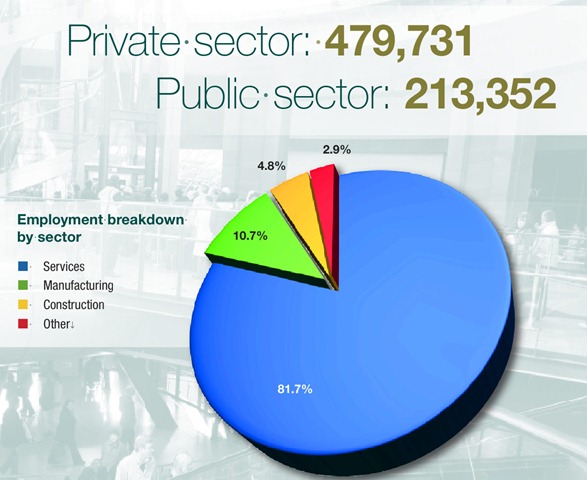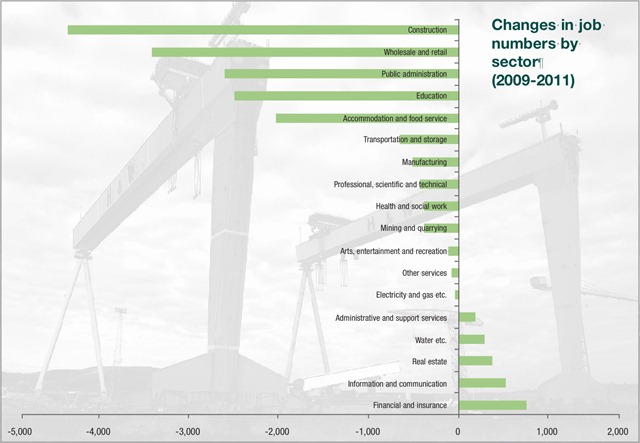Northern Ireland Census of Employment analysis
 Results from the 2011 Census of Employment illustrate the recession’s impact on Northern Ireland’s workforce. Job losses have affected construction and female workers hardest but some service sectors have experienced growth.
Results from the 2011 Census of Employment illustrate the recession’s impact on Northern Ireland’s workforce. Job losses have affected construction and female workers hardest but some service sectors have experienced growth.
The Census of Employment has been carried out every two years since 1987, firstly by the Department for Economic Development and since 2001 by its successor, DETI. It is a full count of the number of employee jobs in all industries except for agriculture, where employment is measured by the Department of Agriculture and Rural Development, and the armed forces. Self-employment is counted separately.
Numbers of male, female, full-time and part-time employees are recorded. The number of people holding jobs, though, is not counted and a person holding a full-time and part-time job, or two part-time jobs, is therefore counted twice.
Northern Ireland’s workforce was made up of 693,083 jobs in September 2011, down from 708,054 two years previously. This fall of 14,971 represented a 2.1 per cent decrease.
The census is based on the actual location of the jobs or the location at which pay records are held, rather than the home address of the employee.
By this measure, employment fell in 20 of the 26 district council areas though for most of those registering increases, these were very small. The six exceptions were Antrim (+4.3 per cent), Dungannon (+2.1 per cent), Cookstown (+1.4 per cent), Strabane (+1.1 per cent), Down (+0.6 per cent) and Carrickfergus (+0.3 per cent).
Belfast experienced a small dip (-0.3 per cent) while Derry’s decrease was close to average (-2.2 per cent). The largest decreases were in Ballymena (-13.8 per cent), Castlereagh (-7.6 per cent) and Lisburn (-6.1 per cent). However, Ballymena’s apparently sharp reduction was mainly due to the outsourcing company Resource re-assigning 2,709 jobs from the district to Belfast for administrative reasons in 2010.
Construction experienced the greatest percentage fall (-11.7 per cent or 4,360 lost jobs). The sector has a strong multiplier effect and a high public profile but accounts for just one in 20 jobs within the workforce. The most recent decrease brings the number of construction jobs down to 1999 levels, meaning that the sector has returned to the baseline that it had before the housing boom.
A 1.8 per cent decrease in the much larger services sector represented the loss of 10,248 jobs. Services, of all types, account for four out of five jobs in Northern Ireland, with manufacturing second and construction third. The ‘other industries’ category includes quarrying and the energy, water and waste utilities.
Losses in the public sector (8,169) outweighed those in the private sector (6,802), although the two trends are related as cuts in the Executive’s budget have a major knock-on effect on public procurement and personal spending.
Women experienced greater job losses than men (10,486 compared to 4,485) while full-time employees were more affected than their part-time counterparts (8,519 and 6,452 respectively) The majority of jobs held by men (80.4 per cent) were full-time whereas female jobs were almost evenly split between full-time and part-time. Within the overall workforce, women held a majority of jobs (51.9 per cent) and the split between full-time and part-time employment was 64.6 per cent to 35.4 per cent.
30.8 per cent of jobs were in the public sector, a slight fall from 31.3 per cent in September 2009. The public sector’s workforce was mainly female (65.5 per cent of jobs) whereas the opposite was true in the private sector, with 77.9 per cent of jobs filled by men.
- Between 2009 and 2011, net increases in jobs were recorded in five sectors:
- finance and insurance (+773);
- information and communication (+542);
- real estate (+386);
- water and related activities (+309); and
- private sector administrative and support services (+201).
However, these were outweighed by decreases in all other sectors. The five sectors with the largest net decreases were construction (as mentioned), wholesale and retail (-3,420), public administration (-2,600), education
(-2,484) and accommodation and food services (-2,031). The Census of Employment is a survey of 55,000 organisations compared to 5,500 surveyed in the Quarterly Economic Survey. It therefore gives a more detailed picture of the workforce although the more frequent quarterly survey results help to give an ongoing up-to-date commentary on the state of economy.
More detailed figures, on the industries within each sector, will be published in January.
Census of Agriculture
The 2011 Census of Agriculture counted 29,143 farmers: 15,823 were full-time and 13,320 part-time. They are supported by 6,263 spouses and 11,442 other farm workers: 3,249 full-time, 3,436 part-time and 4,757 casual or seasonal.
Northern Ireland’s agricultural workforce therefore totalled 46,848 people, down from 48,031 in 2009.
In the intervening time, the number of full-time and part-time farmers decreased by 614 and 510 respectively. The number of full-time farm workers increased by 143 and part-time workers by 216 but there were 460 fewer casual workers.
Self-employment
108,600 people in Northern Ireland were self-employed in June 2012, according to the Quarterly Employment Survey: 65,000 in services, 27,700 in manufacturing and 15,900 in agriculture.
The agricultural figure overlaps with the number of full-time farmers. When farms are excluded, self-employment stands at 92,700 posts. Separately, armed forces personnel stationed in Northern Ireland numbered 3,610 in July 2012.
| Number of jobs | Full-time | Part-time | Total |
| Male | 267,850 | 65,252 | 333,102 |
| Female | 179,966 | 180,015 | 359,981 |
| Total | 447,816 | 245,267 | 693,083 |
Employment by sector and gender
| Sector | Male | Female | Total | ||
| Full-time | Part-time | Full-time | Part-time | ||
| Services | 173,888 | 54,947 | 163,392 | 173,926 | 566,153 |
| Manufacturing | 56,554 | 1,641 | 12,711 | 3,091 | 73,997 |
| Construction | 27,534 | 1,272 | 2,509 | 1,615 | 32,930 |
| Other | 9,874 | 7,392 | 1,354 | 1,383 | 20,003 |
| Private sector | 205,491 | 54,018 | 104,941 | 115,281 | 479,731 |
| Public sector | 62,359 | 11,234 | 75,025 | 64,734 | 213,352 |
| Total | 267,850 | 65,252 | 179,966 | 180,015 | 693,083 |
Detailed breakdown by sector
| Sector | Male | Female | Total |
| Wholesale, retail trade and vehicle repairs | 57,185 | 65,900 | 123,085 |
| Human health and social work activities | 19,606 | 97,595 | 117,201 |
| Manufacturing | 58,195 | 15,802 | 73,997 |
| Education | 16,332 | 51,787 | 68,119 |
| Public administration and defence* | 29,307 | 27,055 | 56,362 |
| Accommodation and food service activities | 18,580 | 22,893 | 41,473 |
| Administrative and support service activities | 23,564 | 17,218 | 40,782 |
| Construction | 28,806 | 4,124 | 32,930 |
| Transportation and storage | 19,431 | 4,990 | 24,421 |
| Professional, scientific and technical activities | 10,531 | 12,268 | 22,799 |
| Financial and insurance activities | 7,839 | 12,504 | 20,343 |
| Information and communication | 10,954 | 5,616 | 16,570 |
| Arts, entertainment and recreation | 7,093 | 6,836 | 13,929 |
| Real estate activities | 3,526 | 3,636 | 7,162 |
| Water supply, sewerage and waste management | 4,293 | 577 | 4,870 |
| Mining and quarrying | 1,487 | 215 | 1,702 |
| Electricity, gas, steam and air conditioning supply | 940 | 343 | 1,283 |
| Agriculture, forestry and fishing** | 583 | 123 | 706 |
| Other service activities | 4,887 | 9,020 | 13,907 |
| Employed by farmers | 9,963 | 1,479 | 11,442 |
| All industries | 333,102 | 359,981 | 693,083 |
* includes compulsory social security schemes
** excluding farmers (self-employed)







